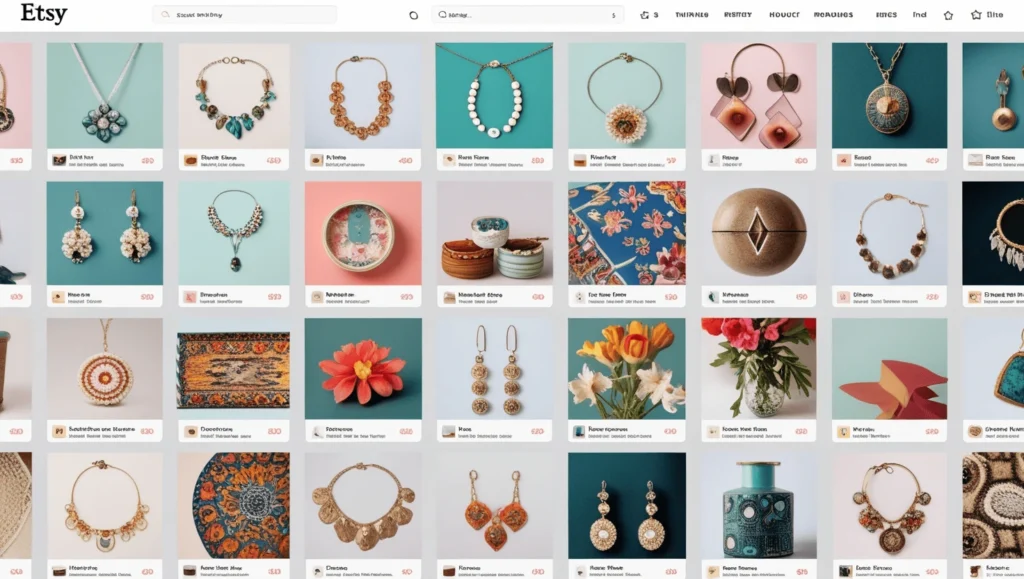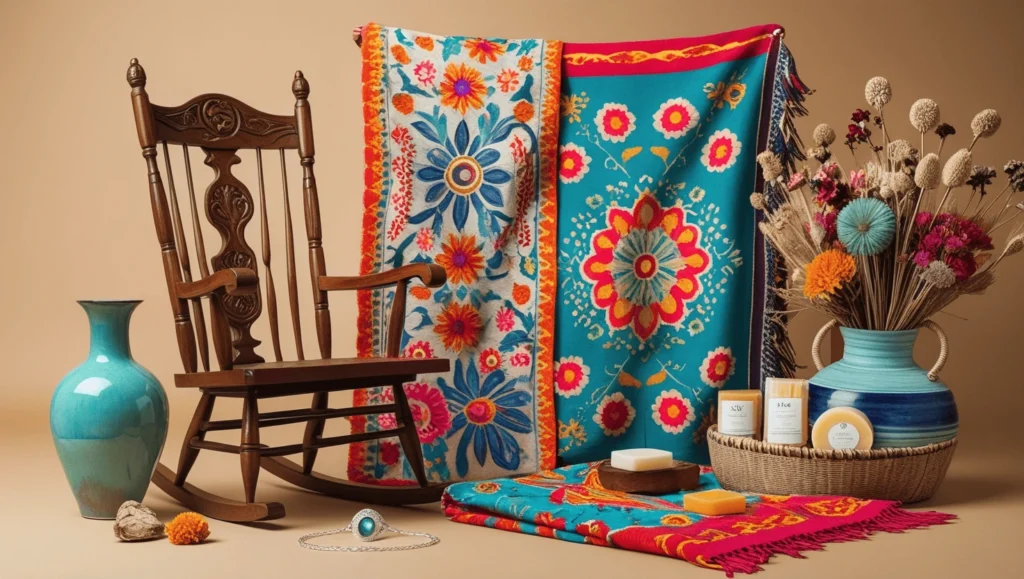The demand for handmade goods is growing rapidly as more people seek unique, high-quality items. Online marketplaces provide artisans with opportunities to reach customers worldwide. Selling handmade crafts online offers several benefits, including lower startup costs and access to a broader audience. Popular platforms such as Etsy, Amazon Handmade, and Shopify make it easier for crafters to showcase their work, connect with buyers, and grow their businesses. In this blog post, we’ll explore some of the best online marketplaces for selling handmade goods and how they can help you reach a global audience.
For more information, explore Etsy’s seller resources, Amazon Handmade, or Shopify’s e-commerce solutions.
Why Sell Handmade Goods Online?
The Benefits of Online Marketplaces for Artisans
Selling handmade goods online provides artisans with numerous advantages. First, these platforms grant access to a global audience, allowing sellers to reach customers far beyond their local markets. This expanded reach increases sales opportunities and helps small businesses grow.
Additionally, selling online comes with a low-cost entry compared to opening a brick-and-mortar store. Sellers avoid hefty rent and utility fees, focusing instead on crafting unique items. Many online marketplaces offer flexible pricing models, making it easier for new artisans to start small and scale over time.
Key Considerations When Choosing a Platform
When selecting a marketplace, there are a few key factors to consider. First, evaluate the platform’s fees. Some sites, like Etsy, charge listing fees and transaction costs, while others, such as Shopify, offer subscription plans with more control over your store. Understanding these costs is essential to maximizing profitability.
Next, think about the audience type. Certain marketplaces cater specifically to handmade goods, such as Amazon Handmade or ArtFire, while others appeal to broader audiences. Choose a platform that aligns with your niche to connect with customers genuinely interested in your products.
Finally, prioritize ease of use. The best online marketplaces for selling handmade goods should offer user-friendly interfaces and tools to help you manage listings, process payments, and track orders effortlessly.
For more tips on selecting the right platform, check out this guide on selling crafts online. It provides insights into fees, audience preferences, and features of popular platforms.

Top Online Marketplaces for Handmade Sellers
Etsy: The Go-To Platform for Handmade Products
Etsy is one of the best online marketplaces for selling handmade goods. It attracts a dedicated audience of buyers who specifically seek unique, handcrafted items. Sellers on Etsy can easily create a visually appealing storefront to showcase their products. This makes it simple to connect with potential customers and build a brand.
One of Etsy’s biggest advantages is its built-in audience. Shoppers visit Etsy with the intention of purchasing handmade goods, which gives sellers immediate access to an interested market. The platform also offers various promotional tools, such as paid ads and customizable storefronts, to help boost visibility.
However, Etsy does have its drawbacks. Sellers must pay listing fees and transaction fees, which can add up, especially for smaller-scale sellers. Additionally, the competition is intense. To succeed, you’ll need to optimize your listings and make your products stand out from the crowd.
Learn more about selling on Etsy and explore other platforms to maximize your reach.
Amazon Handmade: Reach a Wider Customer Base
Amazon Handmade connects artisans with Amazon’s extensive customer base. To sell on this platform, artisans must apply and be approved. This process ensures that only high-quality handmade products are listed, creating a curated experience for shoppers.
How It Works
Once approved, sellers can list their handmade products under the Handmade category. Amazon’s reliable checkout system offers customers a smooth and secure shopping experience. This infrastructure helps artisans reach a larger audience while maintaining trust with buyers.
Amazon Handmade vs. Etsy
Amazon Handmade charges a higher commission fee compared to Etsy but does not have listing fees. The platform targets premium handmade products, attracting a different type of customer. In contrast, Etsy is more community-focused and is often preferred by sellers who value direct interaction with buyers.
To learn more about how Amazon Handmade works and its benefits, visit Amazon Handmade.
Shopify: Build Your Custom Handmade Shop
Shopify allows artisans to create their own online stores. This platform is ideal for sellers who want full control over their branding and website design. Unlike marketplaces like Etsy and Amazon Handmade, Shopify doesn’t cater exclusively to handmade sellers. This means that you’ll need to build your audience from scratch.
Benefits of Using Shopify
With Shopify, you have the freedom to customize your store to reflect your brand. You can design your site to showcase your handmade goods in a way that sets you apart from other sellers. Shopify provides a range of tools, including inventory management, marketing features, and analytics, to help you manage and grow your business effectively.
Scaling Your Business with Shopify
One of the biggest advantages of Shopify is its scalability. If you plan to expand your business, Shopify makes it easy to do so. You can integrate your Shopify store with other sales channels, such as social media and marketplaces like Etsy or Amazon Handmade. This feature allows you to reach a wider audience and drive more traffic to your shop.
By exploring platforms like Shopify, you can choose the one that best fits your business goals. Whether you’re just starting out or looking to expand, selecting the right marketplace is key to your success. Learn more about Shopify.

Lesser-Known Platforms for Selling Crafts Online
If you want to expand your reach as a seller of handmade goods, you may want to explore some lesser-known online platforms. While Etsy and Amazon Handmade are well-known, other marketplaces like ArtFire, Zibbet, and Bonanza offer unique features that can benefit artisans. Here’s an overview of each.
ArtFire: A Community-Focused Platform
ArtFire is a great option for handmade sellers looking for a close-knit, supportive community. One of its biggest strengths is its emphasis on connecting makers and buyers. The platform offers a marketplace for artists to sell their crafts, as well as a community where users can share tips, ideas, and experiences.
The platform is highly customizable, allowing sellers to create their own brand identity. ArtFire’s membership options include different pricing tiers based on your needs. One benefit is its lower fees compared to larger marketplaces, which makes it easier for new artisans to get started. Additionally, ArtFire provides tools to help sellers optimize their listings and reach their target audience.
Zibbet: Sell Across Multiple Channels
Zibbet is a unique platform that allows artisans to sell their handmade products across multiple channels. It integrates with other major marketplaces like Etsy and eBay, so you can manage all your sales from a single dashboard. This makes it an excellent choice for sellers who want to diversify their presence without having to deal with separate accounts for each marketplace.
Zibbet also allows sellers to create their own independent stores, providing full control over branding and product listings. It has a simple fee structure, making it a good option for those starting out or those who want a straightforward platform. Zibbet’s integration with other marketplaces helps streamline inventory management, so you can easily list products across different sites without duplication.
Bonanza: A Unique Marketplace for Artisans
Bonanza stands out as an alternative for handmade goods sellers looking for a unique platform. Unlike Etsy and Amazon Handmade, Bonanza is not as widely known, but it offers valuable features for artisans. One of the key highlights is its low fees, which makes it an appealing choice for new businesses or sellers looking to reduce their operating costs.
Bonanza’s search functionality is designed to help customers discover handmade items through a simple, clean interface. The marketplace has a loyal customer base, and the platform supports a wide range of products. Bonanza is also easy to use, offering an intuitive interface that makes setting up a store quick and straightforward.
Each of these platforms—ArtFire, Zibbet, and Bonanza—offers unique benefits that cater to different types of sellers. Whether you’re looking for a community-driven platform, integration with multiple sales channels, or lower fees, these lesser-known marketplaces are worth considering when selling your handmade goods online. By exploring these options, you can find the right platform that aligns with your business goals.

Tips for Maximizing Success in Handmade Marketplaces
How to Optimize Your Product Listings
To succeed in the best online marketplaces for selling handmade goods, your product listings must stand out. Begin by writing compelling descriptions that clearly explain what your product is and why it’s special. Focus on the benefits and unique features of your items, and make sure your descriptions are easy to read. Use bullet points for important details like dimensions, materials, or customization options.
Alongside your descriptions, high-quality images are essential. Ensure that your photos are clear, well-lit, and show the product from multiple angles. Customers should be able to zoom in to see fine details. A great image can capture attention and encourage a purchase. Make sure your product photos are consistent in style to present a professional brand.
Building Your Brand as a Handmade Seller
Building a strong brand is crucial when selling handmade goods online. Your brand should reflect the values, quality, and uniqueness of your products. Start by creating a memorable logo, choosing a consistent color scheme, and crafting a voice for your brand that resonates with your audience.
Personalize the shopping experience by including a handwritten thank-you note or offering small free samples with every order. A memorable customer experience leads to repeat business and positive reviews. Be responsive to customer inquiries and create a loyal following by maintaining a professional yet friendly demeanor. Building relationships with customers encourages trust and helps establish a long-term, successful business.
Leveraging Social Media to Boost Sales
Social media is a powerful tool to drive traffic to your online store and increase sales. Platforms like Facebook and Pinterest are especially effective for showcasing handmade goods. Start by creating business profiles on these platforms and regularly post high-quality images of your products.
Engage with your followers by sharing behind-the-scenes content, tutorials, or customer stories. Use relevant hashtags to reach a broader audience and collaborate with influencers or other handmade sellers. Facebook ads are also an option to target potential buyers who might be interested in your products. Consistently promoting your work across these platforms will increase your visibility and help build a loyal customer base.
By optimizing your listings, building your brand, and using social media effectively, you’ll set yourself up for success in the competitive world of selling handmade goods online.
Choosing the Right Marketplace for Your Handmade Goods
Comparing Fees and Policies
When selecting an online marketplace for selling handmade goods, it’s important to consider the fees and policies of each platform. Etsy, for example, charges a listing fee of $0.20 per item and takes a 5% transaction fee on sales. Additionally, Etsy collects a payment processing fee based on the total sale price, including shipping. Amazon Handmade, on the other hand, has a 15% referral fee, but it doesn’t charge a listing fee. Both platforms also have policies regarding refunds, customer disputes, and intellectual property. Understanding these costs and policies helps you calculate potential profits and avoid unexpected fees.
Matching Your Niche with the Right Audience
Different online marketplaces attract different audiences, so it’s crucial to choose a platform that aligns with your product type. Etsy, for instance, is known for handmade, vintage, and craft items. If your niche includes unique jewelry or custom home décor, Etsy might be the best choice. Amazon Handmade, however, is ideal for artisans looking to reach a larger, more general audience. It’s a good fit for those selling handmade goods that appeal to mass-market buyers. Consider your product and target audience. Does your work cater to a specific group of buyers, or is it suited for a broader market? Choosing the right platform based on your niche ensures you reach the right customers and boosts your chances of success.
For more insights on choosing the best online marketplaces for selling handmade goods, check out this comparison of Etsy and Amazon Handmade.
Conclusion
In summary, selling handmade goods online opens up incredible opportunities. There are many platforms available, each offering unique benefits. Etsy, Amazon Handmade, and Shopify are popular choices for artisans. However, you should also consider lesser-known options like ArtFire and Zibbet, which may suit specific needs. It’s essential to carefully compare fees, features, and target audiences when choosing the right marketplace for your handmade products. Take the time to research and identify which platform aligns best with your goals. Whether you’re a beginner or looking to scale your business, the right choice can make all the difference. Start selling your handmade goods today and tap into the growing market of online shoppers.
Learn more about the best online marketplaces for selling handmade goods to get started!
